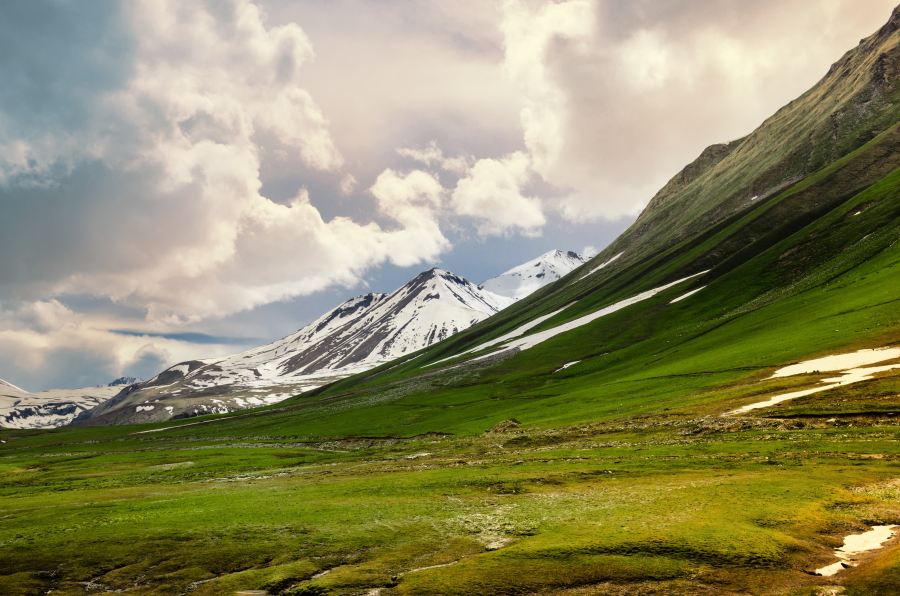The Greeks in ancient times believed that when Prometheus gifted fire to mankind, he was banished and chained by Zeus at the Caucasus Mountains in the far east, and his liver fed to the eagles. No trace of Prometheus remains (in mythology, he was eventually released by Hercules), but the Caucasus Mountains still tower today — not as a prison — but an idyllic geological wonder in what is a fast-growing destination for travelers.
Composed of former Soviet Union constituents and now independent republics Azerbaijan, Armenia and Georgia, the Caucasus Region is sandwiched by Russia to the north and Turkey and Iran to the south. The Caucasus have mountainous boundaries both along Russia (the Greater Caucasus Mountains) and the Middle East (the Lesser Caucasus Mountains), and bordered by water to the west by the Black Sea and east by the Caspian Sea. These geologic features, which have kept the Caucasus from the rest of the world for many centuries, shaped spectacular natural landscapes of valleys and rivers where quaint, thousand-old churches and villages still stand today.
The Caucasus is gradually being unveiled, especially to curious Filipinos. Between 2014 and 2018, Filipino arrivals to the Caucasus rose by 290%, according to Workalife’s Filipino Outbound Travel Index 2019.
Last year alone, this market made more than 27,500 trips to the region, most of which to Georgia. To put that into perspective: Brunei, which is two hours away from Manila, received around the same number of arrivals from the Philippines last year.
Although coming from a low-base, Filipino arrivals to Armenia and Azerbaijan registered some of the largest growth figures across Workalife’s Filipino Outbound Travel Index 2019, rising by 50% and 44%, respectively.
Nearer than Europe

One explanation to the stunning increase in arrivals is the Caucasus’ distance to the Middle East — a hub of overseas Filipino professionals (especially the traveling millennial generation). Tbilisi (capital of Georgia) only takes around three and a half hours by plane from Dubai via flydubai and from Doha via Qatar Airways.
Georgia and Armenia are perfect destinations for travelers looking for a “Winter Wonderland” experience from the Middle East, says Aizy Opeña, a Filipino professional who traveled to the two countries when she used to work and live in Doha. “I flew through Qatar Airways from Doha, arrived in Georgia and then went straight to Armenia through car. After four days, we went back to Georgia again through car and spent three days there before flying back to Doha through QA,” says Aizy.
Philippine passport holders traveling to Georgia can enter the country with e-visas (30 days for every 120-day period) applied online and to Armenia with visa upon arrival. Azerbaijan is a bit tricky as Filipinos need to apply in nearby countries with an embassy (such as Malaysia).
Where to go

Georgia is home to thousand-year old monasteries, such as the Gelati Monastery, listed as a UNESCO World Heritage Site. Built in the 12th century, this well-preserved complex served as a center of culture, science and education during medieval times and reflect the golden age of ancient Georgia.

Tbilisi in Georgia is a popular spot with sulphur baths, the Holy Trinity Cathedral (called locally as Sameba) and other Orthodox Christian churches, cable car and — a dish that mustn’t be missed — khachapuri.


In Armenia, Yerevan is the city to go. It is among one of the world’s oldest continuously inhabited cities, featuring Soviet-era architecture amid rising modern buildings. One must not miss visiting Republic Square, the Yerevan Cascade, the old Aram Street and the handful of museums spread across the city. Zvartnots Cathedral, a church ruins, is a UNESCO World Heritage Site that lies 15 kilometers outside Yerevan.

Lake Sevan in Armenia is the Caucasus Region’s largest body of water. It is a popular beach destination with deep historical and cultural heritage.


Travel tip
The attractions in Georgia and Armenia are far from one another, so a tour package and a travel guide will help, says Aizy. Admittedly, traveling to these countries can be a bit expensive compared to other winter destinations (such as South Korea), but visiting the rustic landscapes unbeknownst to many is an experience that is definitely worth making.
READ NEXT: 6 Places You Shouldn’t Miss in Busan
Featured image of Kazbegi, Georgia is taken by Iman Gozal on Unsplash

